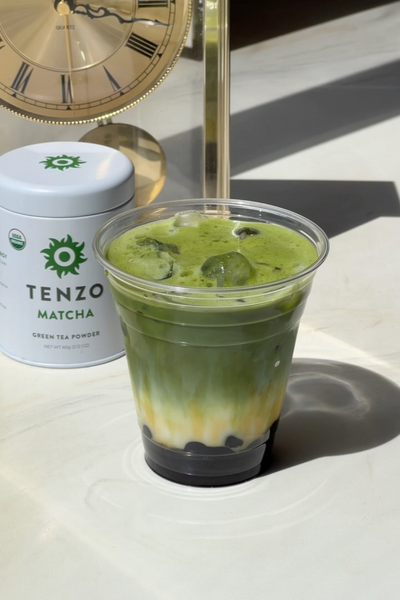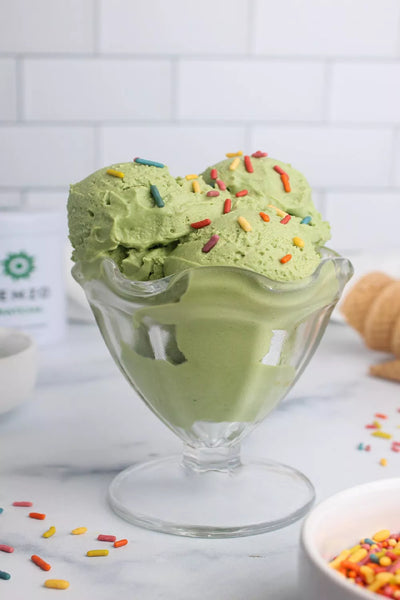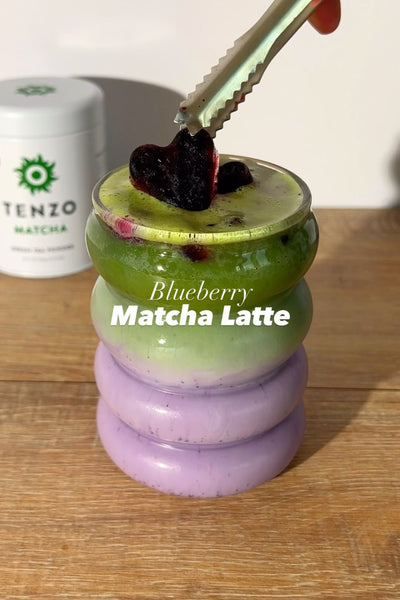What Is Blue Matcha? Comparison to Green Matcha

There are many different ways to get your boost of energy throughout the day, but if you’re looking for that extra focus without the caffeine crash, then matcha might be a good option to fit your needs.
Matcha tea is a low-impact drink that has many unique health benefits without the lasting effects of caffeine headaches, nausea, or crashing.
There are actually a few different matcha options to pick from, which means you’ll be able to find the best type of matcha to fit your lifestyle and health needs. While not all matcha drinks are the same, we make it easy to find the information and decide on which matcha powder is best for you.
Tenzo Tea is here to help. Not only do we carry the tools you need to make a delicious cup of matcha right at home, but we’re sharing our experiences and expertise about modern matcha options so you can create a beautiful, healthy, and delicious matcha drink today.
What’s Blue Matcha?
While blue matcha shares the same name as traditional matcha, it stands entirely on its own.
This popular new drink isn’t actually derived from green tea leaves, the way that green matcha is. Instead, it comes from the blue butterfly pea plant, which is where it gets its unique and beautiful blue coloring.
One thing that blue and green matcha has in common is that they’re both mixed into water, rather than being steeped, the way that most tea is prepared. You’ll still end up with a rich and creamy consistency for your drink, but blue matcha is a unique drink from the traditional type of matcha.
How is Green Matcha Different Than Blue Matcha?
The better we understand the difference between the types of matcha, the easier it will be to find a matcha blend that you can enjoy the taste and health benefits of.
Here are a few of the most important things that set blue matcha apart from its green counterpart.
How They’re Made
Green matcha is harvested from the camellia sinensis plant, which is where it gets most of its health benefits. Blue matcha comes from the butterfly pea plant or Clitoria ternatea.
They are both harvested, ground to a fine powder, and then mixed with water for a creamy, rich drink. The color of the plant can also be used for a natural addition to cakes, ice creams, and other desserts for and beautiful presentation every time.
Is it Caffeinated?
One of the top benefits of matcha green tea is that it delivers on a low-impact, long-lasting caffeine boost without any of the common side effects of drinking coffee, like crashes or headaches.
The caffeine in green matcha is much gentler than that of coffee or other energy drinks, but it can also be known for supporting focus, which makes it a great option for students and professionals, alike.
The Clitoria ternatea is an herbal tea plant, which means that blue matcha doesn’t have any naturally occurring caffeine. It can still be refreshing and rich, however, and is fun to incorporate into many different recipes.
How Do they Taste?
Green matcha comes from a classic green tea plant, which is why you’ll have a fresh, earthy taste in every sip.
By contrast, blue matcha is a much gentler flavor. It’s lighter and a little sweeter but still delivers on some of that earthy flavor. It is also floral in flavor, from the butterfly pea plant, similar to many herbal teas.
What Are They Used For?
One of the reasons it’s so easy to fall for a matcha drink is because it can be used for many different types of recipes.
With green matcha, you’ll add a touch of rich, earthy flavoring to your dish, which is why it’s often mixed in more rich dishes like puddings, brownies, and ice creams. It also mixes well with morning drinks like lattes and smoothies.
If you’re looking for a sweet and gentle flavor for your blue matcha powder, then blue matcha is the way to go. It pairs very well with dairy and cream ingredients, so consider mixing it into your morning latte or even coconut drink.
You can also use blue matcha as an additive for cocktails or take advantage of blue matcha powder to color your cakes and cookies with a beautiful blue hue.
Benefits of Green Matcha
Green matcha is known for its many verified health benefits.
Here are just a few of the health benefits you’ll find in green matcha:
You’ll Stay Alert
Matcha is known for being a great alternative to drinking coffee because it delivers a slow-release sense of alertness and focus and doesn’t cause as many of the side effects often associated with coffee, like jitters or headaches. You also won’t have to worry about the caffeine crash with matcha, the way you will with other caffeinated drinks.
It Can Boost Your Immune System
Green tea leaves are rich in antioxidants and nutrients, which can be very beneficial for boosting your body’s immune system.
If you know you’re going to be around others or if you’re just looking for a jolt of immunity strength, then matcha green tea can be a great option.
It Supports Mental Health
Green tea can be an excellent way to improve overall mental health. It can be soothing and calming and help you to get a good night’s sleep, which can contribute to a sense of relaxation and motivation.
Benefits of Blue Matcha
Blue matcha may not have as many of the verified and quantifiable health and wellness benefits of green matcha, but there are still many reasons you’ll want to consider adding it to your pantry. Here are some of the benefits of blue matcha.
It’s Good for the Nervous System
Blue matcha can be an excellent tool for managing the effects of stress because it targets the nervous system and reduces feelings of overwhelm that contribute to stress. If you begin to feel jitters or you’re under a lot of pressure at work or school, blue matcha can be a beneficial tool.
It Soothes Tension
Tea is often used to help reduce feelings of tension and bloating. Not only will it help to improve your digestion and make you feel comfortable and well-regulated, but it can also target the kind of tension that causes joint pain and irritation.
Blue matcha is a great option for those with stiffness of the joints or stress from sitting in the same office chair all day.
It’s Good for the Skin
There are many different types of teas that can be used to improve hair and nail health and support smooth and soft skin, and blue matcha is one of them. It also helps to support anti-aging, which can help to reduce the appearance of fine lines and wrinkles that contribute to aging.
When you enjoy blue matcha regularly, you may also notice that your hair and nails are growing stronger and longer, as well.
It’s a Gorgeous Color
Not only is blue matcha a great choice for sweet, floral flavoring that can be mixed into all of your favorite recipes, but it comes in a vibrant, lasting color that always makes a statement.
Impress your Instagram followers with beautifully colored smoothie bowls and pastries, and then dig into a delicious dish that you’re sure to love with every bite.
In Summary
Green matcha is one of the most common and well-known coffee alternatives and it’s not hard to see why. It has many health and wellness benefits and can be used for everything from boosting your immune system to supporting your mental health.
But green tea isn’t the only option available to you. You can also try out blue matcha tea, which is a type of herbal tea that doesn’t come with any caffeine, unlike green matcha. It produces a bold and brilliant color and can be used in a wide variety of recipes for the floral, subtle flavoring, and bright hue.
Green and blue matcha have some commonalities and some differences.
They are harvested from different tea plants, but both made into fine powder and mixed into water or other ingredients. They have a slightly different taste, with green tea tasting earthier and fresher and blue tea offering up a more floral flavoring, and green matcha is caffeinated, where blue matcha is not.
For more information on the different types of matcha options and for how to begin brewing your next cup of matcha right at home, visit Tenzo Tea today.
Sources:
4 Reasons to Try Matcha and is Blue Matcha as Good as Green Matcha? | Wise Living Magazine
Clitoria ternatea | North Carolina Extension Gardener Plant Toolbox
Managing Stress | National Alliance on Mental Illness










